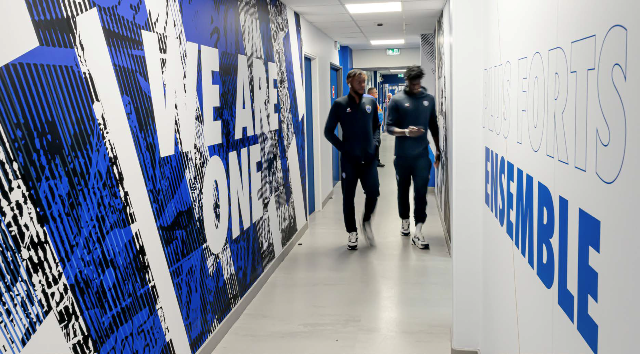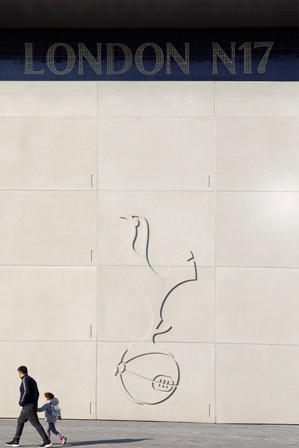In Focus: Populous – Wayfinding & Brand Activation
Simon Borg, Head of Brand Activation at Populous EMEA explains the science behind Wayfinding and Brand Activation in the stadium environment and how they’re helping venue owners and operators develop enhanced fan experiences and more valuable commercial opportunities.
Alongside its core architecture and venue design practice, Populous has evolved a range of services and sub-brands that enable it to provide a full end-to-end service for potential clients as they look at a new venue, or upgrades to their existing one.
One such service is the often taken for granted element of wayfinding. How often have you been to a venue where you’ve been able to find the way you want to go without any fuss? Conversely, how often have you been left frustrated by the lack of visual guidance?

Populous brand activation for FC Troyes
Populous understands the importance of this element of stadium design and has built up a dedicated business vertical to work across the design process to ensure wayfinding is clear, easy to use and importantly, fits with the overall design and visual identity of the venue.
“We’re very passionate about understanding the unique requirements of football environments”
Whilst you expect to find your way around and often take it for granted that there’s clear signage and information to guide you, there’s a whole science behind this as Simon Borg, Head of Brand Activation at Populous EMEA explains.
“You do this using both human psychology and the dynamics of the fans and crowd movement to make it as accessible and easy to navigate as possible,” he says.
“We’re very passionate about understanding the unique requirements of football environments. It’s important to understand what a football stadium stands for. Even if it’s a big new shiny 62,000 seat stadium like Tottenham’s or its Everton’s old stadium which has been around for over one hundred years. There’s some uniqueness about going to a football match that we like to tap into.”
Wayfinding is often the invisible part of stadium design and encompasses several mechanisms that are used to enhance the fan experience. It can also be used to adjust the behaviour of fans and the way they approach a stadium.
Borg further explains: “The idea is that we understand how people behave and how they move, as well as where they are at any point in an event day cycle. It tunes into their needs, and it enables them to get to where they want to get to and find the things they want to find. Essentially, we must consider the design of the building when we’re doing it. Fans should be able to move around seamlessly, find what they need and find their seat in a venue without realising they’ve used the signage.”
Tottenham Hotspur’s new stadium provides a best-in-class example of wayfinding with its use of static and digital signage which can be adapted per event, per audience. Using its adaptability, they can direct fans to specific areas at specific times. But this is all underpinned by understanding how ritualistic fans are.
“Fans often get off at particular station, they go to a particular pub, they sit in a particular seat and then head to the stadium at a particular time. That is passed on from generation to generation and it’s really embedded.
“When we were looking at Tottenham, and other clubs like Manchester City, we knew that if we were to change behaviours and get people to move in different ways then we needed to focus on changing the behaviour of groups such as families that come early, tourists that are visiting for the first time, general first-time users and VIPS.
“We developed a range of activities that get them to engage earlier that the more traditional ritualistic fans will start to see over a period of time. If you can get a proportion of the crowd to do something and move them in a certain direction, then over eventually that can change behaviours of others and get them to experience a fuller matchday environment.”
So what can be done to make a fuller matchday environment? Brand activation and experiential design are another key element of the Populous offer and are often linked to commercial partnerships.
“If we’re working on a new build, we’ll identify in the stadium itself opportunities to build experiences within it. Additionally, we’ll identify opportunities external to the venue on the approach by mapping out the journey of each of the users and where we can engage or provide interventions.
“We then build an eco-system of experiences for that venue. The next process is mapping out what those experiences are and really start to look at them in detail. We can then start to identify the types of partners that would be attracted to those particular experiences.”
“Fans should be able to move around seamlessly, find what they need and find their seat in a venue without realising they’ve used the signage”
By assessment and audit to understand the building, the Populous team works with the venue owners, operators and commercial teams to understand the value of the properties and decide what they can do to enhance the experience within it.

Branding at the Tottenham Hotspur Stadium
Borg continues: “From that point we then start to focus in on particular brands that might be interested. How does a brand own parts of the building, does it look like it’s always been there, does it provide a direct experience to the users of that building and as a consequence of that does it give value back to the partner and allow them to have better engagement with a wider group of people?”
Populous developed a unique brand proposition for the O2 Arena in London with the brief focused on ensuring it looked and felt like the mobile network brand were integral to the building.
“From the beginning we worked really closely with O2 and their brand managers to develop the idea of the brand DNA and how that manifests itself in the building. We then worked with the architect to bring that to life.
“We took the analogy of the venue bleeding blue light, and the idea was that it was built for O2, even though it wasn’t.
“Rather than going to a brand and saying here’s some poster sites, you can fill them, it’s about alternative experiences – you can do the VIP drop off and you could create a whole space so when people come in it’s all about you. From that it’s about delivery and building it into the architecture of the venue and making sure it completely gels.
“Most recently we’ve worked on Co-op Live, the new music arena in Manchester that will open in April, working directly with Co-op to really get under the skin of their brand, understand their philosophy in more depth and develop a placemaking strategy in relation to the brand and its location. That will influence how the concourses look, the offer that is presented within the F&B areas and the interiors that bring it to life. That becomes the nucleus for how this building behaves and feels.”
It’s clear that wayfinding and brand experiential design overlap and to do both effectively, they need to work in unison, as Borg concludes: “Our role is two-fold. It’s about mapping journeys and understanding what people’s engagement points are. That could be giving them a simple piece of information to turn left or right but also recognising that’s an opportunity to have interventions and provide commercial opportunities.
“But it’s also about working with the owners of a venue to give them the assets and conceptual ideas they can go to market and sell.”
Main image: Wayfinding at the London Stadium – Populous





